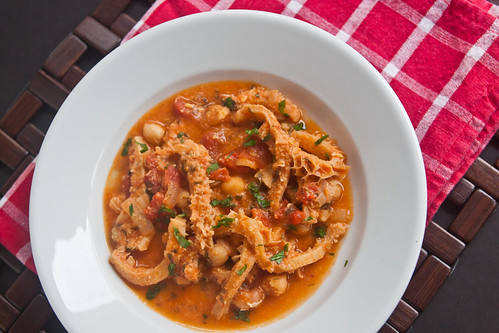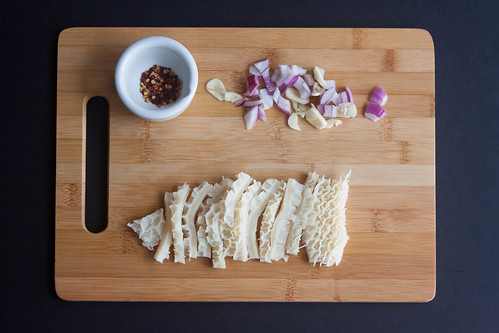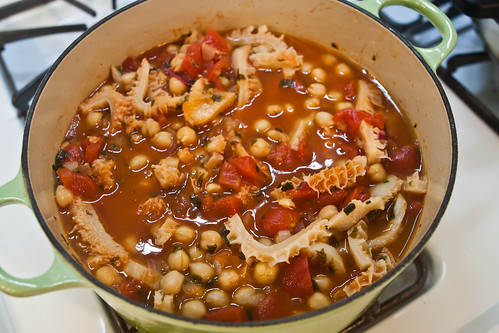If someone wanted to ease a friend or family member into trying offal meats, tripe is probably the most logical starting point. Properly cleaned and processed, it takes on the flavors of whatever it’s been cooked in and has great textural complexity. If the person you’re trying to convert can somehow get over the fact that tripe is the lining of a cow’s stomach, it’s one of the tastier, somewhat more innocuous of offal meats. When Gourmet magazine publishes an Asian tripe recipe, you know its time has come indeed.
I grew up eating tons of the stuff – mostly in the dimsum restaurants I frequented with my family, steamed with ginger, scallion and shiaoxing wine, and in a Filipino dish called kare-kare, which also contains oxtail in a peanutty sauce. But I’d never cooked it myself until now, with DD away camping with his friends. I waited until I had the house to myself just in case any untoward odours were to invade the home, and I wanted to ensure that my smell-sensitive husband was subjected to nothing that might turn him away from liking tripe.
Of the tripe dishes I’ve sampled here in the States the ones at Osteria Mozza (Batali), A16 (Nate Appleman) and Incanto (Chris Consentino) stand out the most and have been the tastiest. I was able to find the Batali recipe and A16’s, and eventually decided on the A16 version, along with some enhancements by Flickr friend bertabetti. Basically the procedure is similar – boil the tripe for a while until tender, add in the flavourings, and simmer some more until the tripe has taken on the texture and flavours you desire.
bertabetti’s version calls for the addition of a pigs’ trotter and garbanzo beans; I eschewed the former for another time, choosing the latter to add to the recipe. If using dried garbanzo beans, make sure to start soaking the beans the night before you plan on cooking the tripe. In fact, make sure to leave yourself some time to make the dish in its entirety – it does take a while and isn’t something to whip up on a weeknight after work.
Ingredients
- 2 pounds honeycomb tripe, cleaned and ready to cook
- 1/4 cup white vinegar
- Kosher salt
- 1 cup garbanzo beans
- 1 chopped celery stick
- 1 chopped carrot
- 1 chopped onion
- 1/2 cup extra virgin olive oil, plus more for finishing
- 1 red onion, diced
- 2/3 cup coarsely chopped fresh flat-leaf parsley
- 6 cloves garlic, thinly sliced
- 1/3 teaspoon dried chile flakes, or to taste
- 1/3 cup tomato paste
- 1/5 cups dry white wine
- 2 cups canned imported Italian tomatoes with juice, coarsely chopped
- 2 cups water
- 1 egg
- 1/2 cup grated Parmesan cheese
Procedure
1. If using dry garbanzo beans, put the soaked beans into a large pot with the chopped celery, carrot and onion. Bring to a boil and simmer for an hour until it retains just a hint of a bite. Strain out the aromatics and set aside the garbanzo beans.
2. While the beans are cooking, rinse the tripe well under cold running water. Place it in a large, heavy bottomed pot and add vinegar, a few healthy tablespoons of salt (it is important the water is salty), and water to cover by several inches. Bring slowly to a boil, adjust the heat to a simmer, and skim off any foam from the surface with a ladle. Cook the tripe, uncovered, for about 2 hours, or until it can be easily pierced with a fork. (Note: because the tripe I purchased had already been prepared and processed, it was tender enough to be pierced with a fork after around an hour, and that’s when I turned off the heat. When I make this dish again, I would boil the tripe for 1.5 hours at least. When I began to taste the dish towards the end, I definitely wanted the tripe to be more tender.) Remove from the heat and let the tripe cool in its cooking liquid.
3. Transfer the cooled tripe to a large cutting board, and discard the cooking liquid. Cut the tripe into 2-inch-wide ribbons, and then slice the ribbons crosswise into thin ¼-inch-wide strips. Set aside.
4. In a large, heavy-bottomed pot, heat 1/2 cup of the olive oil over medium heat. Add the onion, parley, garlic, chile flakes, and about 1 teaspoon salt and cook, stirring frequently, for about 5 minutes, or until the onion has softened.
5. Stir in the tomato paste and continue to cook for 5 minutes, or until the tomato paste changes from bright red to brick red. Pour in the wine and deglaze the pot, dislodging any browned bits from the bottom and reducing the mixture until it is almost dry. Add the tripe, garbanzo beans, tomatoes and their juice, and water and bring to a simmer. Continue to simmer, uncovered, for about 30 minutes, or unit the tripe has absorbed the flavor from the sauce and is very tender. (Note: I simmered the tripe for another 30 minutes, since after tasting it I was not completely pleased with the texture – still too firm for me.)
6. At this point, the mixture should have the consistency of a thick soup. If it’s is too thick and has a consistency more like oatmeal, add a splash of water to loosen it up. It will thicken further once you add the egg and the cheese. Taste for seasoning and add more salt if needed.
7. In a small bowl, beat together the egg and parmesan until blended. Stir the mixture into the tripe stew and heat, stirring a few times, for about 1 minute, or just until the stew thickens.
8. Serve the tripe in warmed bowls. Top each bowl with a drizzle of olive oil and a scattering of bread crumbs. Serve immediately.
I paired the trippa with Heaven and Hell pasta, a Judy Rodgers (Zuni) recipe adapted by the Amateur Gourmet. DD loved the meal and had seconds, even asking to eat leftovers the next day. This is definitely going into rotation, and next time I’ll add that pig’s trotter.
More photos on Flickr here.


